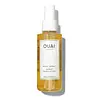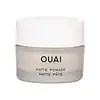Ouai Wave Spray Versus Ouai Matte Pomade
What's inside
What's inside
 Key Ingredients
Key Ingredients

 Benefits
Benefits

 Concerns
Concerns

 Ingredients Side-by-side
Ingredients Side-by-side

Water
Skin ConditioningPPG-5-Ceteth-20
EmulsifyingIsobutylene/Ethylmaleimide/Hydroxyethylmaleimide Copolymer
Polysorbate 20
EmulsifyingPropanediol
SolventAlcohol Denat.
AntimicrobialTamarindus Indica Seed Gum
Emulsion StabilisingCocos Nucifera Water
MaskingGlycerin
HumectantPanthenol
Skin ConditioningPhyllostachys Bambusoides Juice
Skin ConditioningHydrolyzed Hibiscus Esculentus Extract
Skin ConditioningDaucus Carota Sativa Root Extract
Skin ConditioningJasminum Officinale Flower Extract
MaskingNasturtium Officinale Extract
PerfumingZingiber Officinale Root Extract
MaskingAmaranthus Caudatus Seed Extract
Skin ConditioningOryza Sativa Extract
AbsorbentCystoseira Compressa Extract
Hydrolyzed Linseed Extract
Skin ConditioningPisum Sativum Extract
Skin ConditioningLaurdimonium Hydroxypropyl Hydrolyzed Keratin
Skin ConditioningHydrolyzed Rice Protein
Skin ConditioningOryza Sativa Seed Protein
AntioxidantHydrolyzed Corn Protein
Skin ConditioningHydrolyzed Yeast Protein
Skin ConditioningSodium PCA
HumectantSodium Lactate
BufferingArginine
MaskingAspartic Acid
MaskingPCA
HumectantGlycine
BufferingAlanine
MaskingSerine
MaskingValine
MaskingProline
Skin ConditioningThreonine
Isoleucine
Skin ConditioningPhenylalanine
MaskingHistidine
HumectantZea Mays Starch
AbsorbentTocopherol
AntioxidantMoringa Oleifera Seed Extract
Skin ConditioningSodium Polystyrene Sulfonate
Emulsion StabilisingCystine Bis-Pg-Propyl Silanetriol
Skin ConditioningHydrolyzed Vegetable Protein Pg-Propyl Silanetriol
Skin ConditioningEthylhexylglycerin
Skin ConditioningParfum
MaskingPolysilicone-15
UV FilterLeuconostoc/Radish Root Ferment Filtrate
AntimicrobialPentylene Glycol
Skin ConditioningDisodium Phosphate
BufferingCitric Acid
BufferingChlorphenesin
AntimicrobialBenzyl Alcohol
PerfumingDehydroacetic Acid
PreservativeDisodium EDTA
Aminomethyl Propanol
BufferingBHT
AntioxidantCaprylyl Glycol
EmollientPhenoxyethanol
PreservativePotassium Sorbate
PreservativeSodium Benzoate
MaskingGluconolactone
Skin ConditioningCalcium Gluconate
HumectantPhytic Acid
Phenethyl Alcohol
MaskingLinalool
PerfumingAlpha-Isomethyl Ionone
PerfumingLimonene
PerfumingGeraniol
PerfumingHydroxycitronellal
PerfumingCitronellol
PerfumingCI 42090
Cosmetic ColorantCI 17200
Cosmetic ColorantCI 19140
Cosmetic ColorantCI 15985
Cosmetic ColorantWater, PPG-5-Ceteth-20, Isobutylene/Ethylmaleimide/Hydroxyethylmaleimide Copolymer, Polysorbate 20, Propanediol, Alcohol Denat., Tamarindus Indica Seed Gum, Cocos Nucifera Water, Glycerin, Panthenol, Phyllostachys Bambusoides Juice, Hydrolyzed Hibiscus Esculentus Extract, Daucus Carota Sativa Root Extract, Jasminum Officinale Flower Extract, Nasturtium Officinale Extract, Zingiber Officinale Root Extract, Amaranthus Caudatus Seed Extract, Oryza Sativa Extract, Cystoseira Compressa Extract, Hydrolyzed Linseed Extract, Pisum Sativum Extract, Laurdimonium Hydroxypropyl Hydrolyzed Keratin, Hydrolyzed Rice Protein, Oryza Sativa Seed Protein, Hydrolyzed Corn Protein, Hydrolyzed Yeast Protein, Sodium PCA, Sodium Lactate, Arginine, Aspartic Acid, PCA, Glycine, Alanine, Serine, Valine, Proline, Threonine, Isoleucine, Phenylalanine, Histidine, Zea Mays Starch, Tocopherol, Moringa Oleifera Seed Extract, Sodium Polystyrene Sulfonate, Cystine Bis-Pg-Propyl Silanetriol, Hydrolyzed Vegetable Protein Pg-Propyl Silanetriol, Ethylhexylglycerin, Parfum, Polysilicone-15, Leuconostoc/Radish Root Ferment Filtrate, Pentylene Glycol, Disodium Phosphate, Citric Acid, Chlorphenesin, Benzyl Alcohol, Dehydroacetic Acid, Disodium EDTA, Aminomethyl Propanol, BHT, Caprylyl Glycol, Phenoxyethanol, Potassium Sorbate, Sodium Benzoate, Gluconolactone, Calcium Gluconate, Phytic Acid, Phenethyl Alcohol, Linalool, Alpha-Isomethyl Ionone, Limonene, Geraniol, Hydroxycitronellal, Citronellol, CI 42090, CI 17200, CI 19140, CI 15985
Petrolatum
EmollientKaolin
AbrasivePEG-7 Glyceryl Cocoate
EmulsifyingHydrogenated Soybean Oil
EmollientParaffin
PerfumingParaffinum Liquidum
EmollientParfum
MaskingSynthetic Beeswax
Emulsion StabilisingMicrocrystalline Wax
Emulsion StabilisingBHT
AntioxidantBenzyl Benzoate
AntimicrobialBenzyl Salicylate
PerfumingCitronellol
PerfumingLinalool
PerfumingStearic Acid
CleansingHexyl Cinnamal
PerfumingHydroxycitronellal
PerfumingGeraniol
Perfuming
 Reviews
Reviews

Ingredients Explained
These ingredients are found in both products.
Ingredients higher up in an ingredient list are typically present in a larger amount.
BHT is a synthetic antioxidant and preservative.
As an antioxidant, it helps your body fight off free-radicals. Free-radicals are molecules that may damage your skin cells.
As a preservative, it is used to stabilize products and prevent them from degrading. Specifically, BHT prevents degradation from oxidation.
The concerns related to BHT come from oral studies; this ingredient is currently allowed for use by both the FDA and EU.
However, it was recently restricted for use in the UK as of April 2024.
Learn more about BHTCitronellol is used to add fragrance/parfum to a product. It is often derived from plants such as roses. In fact, it can be found in many essential oils including geranium, lavender, neroli, and more. The scent of Citronellol is often described as "fresh, grassy, and citrus-like".
Since the Citronellol molecule is already unstable, Citronellol becomes irritating on the skin when exposed to air.
Citronellol is a modified terpene. Terpenes are unsaturated hydrocarbons found in plants. They make up the primary part of essential oils.
Citronellol is not able to be absorbed into deeper layers of the skin. It has low permeability,
Citronellol is also a natural insect repellent.
Learn more about CitronellolGeraniol is used to add fragrance/parfum to a product. It is the main component of citronellol. It is a monoterpenoid and an alcohol.
Monoterpenes are naturally found in many parts of different plants.
Geraniol can be found in many essential oils including Rose Oil and Citronella Oil. The scent of Geraniol is often described as "rose-like". Many foods also contain Geraniol for fruit flavoring.
Geraniol can irritate the skin when exposed to air. However, irritation depends on the ability of geraniol to penetrate into the skin. In general, geraniol is not able to penetrate skin easily.
Geraniol is colorless and has low water-solubility. However, it is soluble in common organic solvents.
Like citronellol, it is a natural insect repellent.
2,6-Octadien-1-ol, 3,7-dimethyl-, (2E)-
Learn more about GeraniolHydroxycitronellal is a fragrance created from citronellal. The smell of hydroxycitronellal is often described as "citrus-like" or "melon-like".
Hydroxycitronellal is a known EU allergen and may cause irritation when applied to the skin.
Linalool is a fragrance and helps add scent to products. It's derived from common plants such as cinnamon, mint, citrus, and lavender.
Like Limonene, this ingredient oxidizes when exposed to air. Oxidized linalool can cause allergies and skin sensitivity.
This ingredient has a scent that is floral, spicy tropical, and citrus-like.
Learn more about LinaloolParfum is a catch-all term for an ingredient or more that is used to give a scent to products.
Also called "fragrance", this ingredient can be a blend of hundreds of chemicals or plant oils. This means every product with "fragrance" or "parfum" in the ingredients list is a different mixture.
For instance, Habanolide is a proprietary trade name for a specific aroma chemical. When used as a fragrance ingredient in cosmetics, most aroma chemicals fall under the broad labeling category of “FRAGRANCE” or “PARFUM” according to EU and US regulations.
The term 'parfum' or 'fragrance' is not regulated in many countries. In many cases, it is up to the brand to define this term.
For instance, many brands choose to label themselves as "fragrance-free" because they are not using synthetic fragrances. However, their products may still contain ingredients such as essential oils that are considered a fragrance by INCI standards.
One example is Calendula flower extract. Calendula is an essential oil that still imparts a scent or 'fragrance'.
Depending on the blend, the ingredients in the mixture can cause allergies and sensitivities on the skin. Some ingredients that are known EU allergens include linalool and citronellol.
Parfum can also be used to mask or cover an unpleasant scent.
The bottom line is: not all fragrances/parfum/ingredients are created equally. If you are worried about fragrances, we recommend taking a closer look at an ingredient. And of course, we always recommend speaking with a professional.
Learn more about Parfum